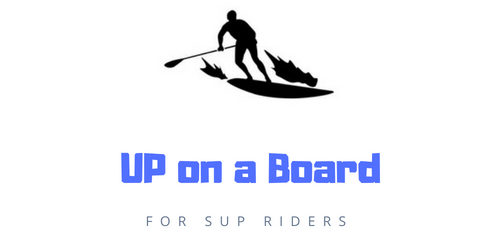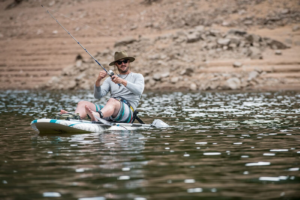Ultimate Guide to SUP Fishing
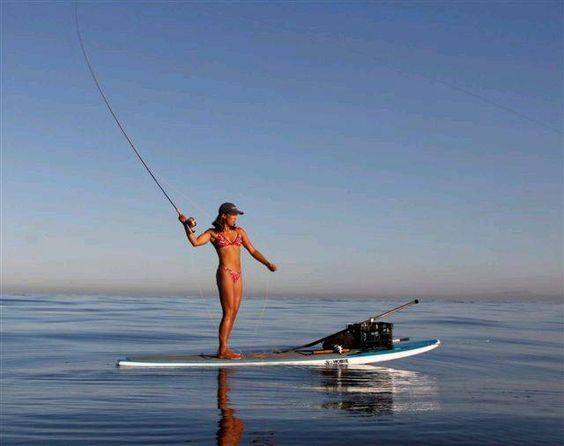
Many of us have developed a love for fishing long before ever stepping foot on a paddle board. If you’re looking for a relaxing and enjoyable time on your SUP, then fishing could be just what you need.
Why should I fish on a paddle board? If you’re a fan of fishing, then fishing on a paddle board should be something that you consider. These are a few reasons why:
- More Affordable- The cost for renting or purchasing a boat can be costly. Plus you can have the added maintenance costs. Some paddle boards are only a few hundred dollars.
- Low Maintenance- Caring for a paddle board is much less intensive than maintaining a small engine on a boat.
- Easier to Transport- A trailer is often needed to tow a boat to the water. An inflatable SUP can be transported in the back seat of your car.
- Easier to Store- You’ll need a large area to store any kind of boat, where as a paddle board can easily be stored out of sight.
- Offshore Fishing- Gives you an opportunity to fish in deeper waters versus only fishing from the shoreline.
- Stand up View- Unlike a canoe or Kayak, a SUP gives you an easy way to stand up while on the water which helps with casting, fly fishing, or just being able to see the water better.
- Quiet- You won’t scare the fish away as easily on SUP, compared to a motor boat.
- Stay Fit- Standing on a paddle board will keep your core engaged while maintaining balance.
What makes Fishing Fun?
I’ve always enjoyed fishing as an opportunity to get away from the daily grind. It’s been fun for me to go with some family or friends to bond while being out on the water.
Being on the water has always helped me to recharge, think, or gain a better perspective on my life. Fishing has provided me a source of pride when I’m able to get that big catch.
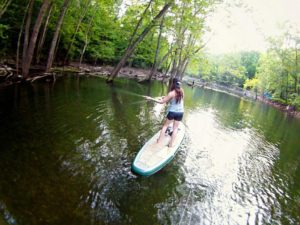
Here are some of the things that make fishing enjoyable and why it can enhance your SUP life:
Relaxing
Fishing has been a recreational activity since the beginning of time. Fishing allows you to just get away from the stresses of daily life.
Breathing in the fresh air, listening to the soothing sounds of the water, and observing nature have a natural calming effect.
I write in my post relaxing with a SUP, all of the different ways that paddle boarding can be relaxing which equates to what the fishing experience on your SUP can provide.
Teaches Patience
Don’t we all need to learn to have a little more patience. With our fast paced society and need for immediate gratification, things that teach us how we can be rewarded by waiting can help us in so many ways.
Provides a Challenge
It’s not always easy to catch a fish. It takes utilizing the right types of bait, going at the right time of day, being in the right spot, and sometimes using the right technique.
Can Eat It
One awesome perk to going fishing is that you can eat the fish. Although fish is an acquired taste, it provides so many amazing health benefits.
Fish are loaded with Omega-3 fats that can be hard to incorporate into our diets. Omega-3 can help with heart health, reduce inflammation, brain functioning, and much more.
Fishing Tips for a Beginner
When to Go– Typically the best times of the day to fish are dawn and dusk. So, early morning until the sun is fully up or evening as the sun is going down.
Think about the times when bugs are most active since that is what fish primarily eat or how when the water gets too warm, fish will migrate out to deeper waters.
Typically, Spring and Fall are better times to fish throughout the year, but that can vary based on the type of fish that you are trying to catch.
Spots to Fish– Looking for areas with weeds, lily pads, logs or other objects that provide areas for fish to hideout are good spots to fish.
Small cove areas or near damns are generally good fishing spots. Spots that contain a large amount of small fish can be an indication that larger fish are around.
Learn how to tie some basic knots– A Palomar knot is a simple basic knot to secure a hook to your line
Here is a video of how to tie this knot:
Choosing Bait– Both live bait and artificial baits can be successful, but for the beginner I’d stick with using live bait. Live bait can be things like worms, minnows, crickets, grubs, or grasshoppers.
Keeping the bait alive on the hook so they’re moving will help attract fish. If you’re fishing in salt water, different types of live bait are used which would include things like shrimp, small fish, squid, eel, crab, or sea worms.
As you become more involved in fishing you can progress to learning about various lures, spinners, and artificial bait.
How to Cast
- Hold the rod on the side that you will be casting from at about waist level. The hook should be hanging about 1-2 feet from the end of the pole.
- Hold the line with your forefinger while flipping up the bail on a spinner reel or pushing the button on a bait caster rule while continuing to hold the line with your forefinger.
- Bring the rod back over your shoulder on your dominant side and fling it forward towards the water. Release your finger when the rod is flung just past your head.
- As the bait sinks into the water, flip the bail back down on a spinner reel. Slowly reel a couple times until you hear a slight click to engage the anti-reverse.
Tighten the slack– You tend to have a lot of slack from the fishing line after casting. Slowly really in until the line is taught, so you can have a better feel for a bite.
This will be done continuously as the line continues to develop slack or the line has fully been reeled in.
Setting the Hook– This is important to ensure that you properly hook the fish when they bite your line. Otherwise, the fish will just take your bait and swim on.
This is done by giving a quick jerk back on your fishing pole when you feel or see a possible bite.
Set the Drag– After you set the hook, the last thing you want is for the line to snap. Setting the drag on your reel before you use it will help prevent line snaps.
On a spinner reel, the drag adjustment will be right on top of the reel. It will allow you to turn it to adjust the drag. Test it by pulling on the line to see how easy it is to pull out.
It’s better to be a little on the loose side. Push button reels have a drag adjustment on the side that works the same way.
Reel in a Fish– Depending on the size and fight of the fish will determine how much of a challenge it will be to reel it in. Let the drag and rod work for you.
Keep your rod down and continue to reel in. You can pause at times to let the fish tire out. Have your net ready to scoop it up.
Releasing the Fish– When you’re fishing for fun and not for food, you’ll want to release the fish back into the water. You can do this without causing serious harm or death to the fish.
Do your best to hold your fish horizontally without pressing on the gills and eyes. Push back on the hook to un-jar it from the mouth. Use a hook removal tool if necessary.
This process should go as quick as possible and the fish can be gently tossed back into the water.
What do I need to fish on a paddle board
- Fishing License- Check your local fish and game department to determine what types of license’s your state requires for fishing and the costs.
- The Right Board- You want a large enough SUP to hold your gear and provide enough balance for fishing.
- Life Vest or PFD- This is necessary to keep you safe while out on the water
- Net, Bucket, Rod, Tackle- You aren’t going to catch any fish without some fishing equipment
- Pole holders- Paddle boards don’t provide options for going hands free with your fishing pole, unless you run the risk of losing your pole in the water. Purchasing a pole holder is going to make things a lot easier
- Anchor- An anchor will allow you to hang out in one area versus drifting everywhere. Here is my in-depth post on using a paddle board anchor
- Cooler- This can be great for storing bait, gear, or just carrying beverages. If you decide not to utilize a chair, the cooler could act as an option for seating.
- Bucket- If you intend to bring the fish back to eat, you’ll need something to store them in.
Paddle Board Fishing Set-Up
Now that you know the basic essentials to get you started with SUP fishing, let’s talk a little bit about getting your SUP set-up for fishing. The first thing that may come to mind is where are you going to keep that paddle.
This YakAttack Kayak RotoGrip Paddle Holder GRP-1001 will help to secure your paddle to your board without any problems.
Next, To sit or not to sit that is the question. I would recommend having the option to sit down. Check out my post on sitting on a paddle board for options.
You could also utilize a cooler or storage box to sit on which can help with your gear. Lastly, you’ll need a set-up for holding your rod.
One option is to get something to go on your storage box or to have something to go directly on your board. Here is an option Engel USA Cooler 30 qt.
Finding the Right Paddle Board for SUP Fishing
If fishing is going to be a major part of your SUP life, then finding a board that is more suited towards fishing will be beneficial.
I recommend the below SUPs because they include bundle many of the necessary accessories to optimize your board for fishing.
California Board Company 10’6″ Voyager Stand Up Paddleboard Package with Seat & Fishing Rod Holder
Sea Eagle FishSUP 126 Inflatable FishSUP – Swivel Seat Fishing Rig Package
Where to fish and what to fish for on a paddle board
Paddle boards are going to be somewhat limited with what type of fish you are going to try to catch. It’s going to be difficult to fish for large fish or deep water fishing on a paddle board.
Fishing on the ocean or rough waters will also present challenges. It’s going to be best to fish for small to medium sized fish on lakes.
Salt Water
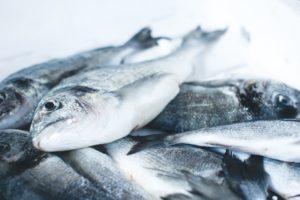
The ocean and various bodies of salt water are home to a myriad of aquatic life. Many varieties of fish live in salt water that are tasty to eat.
Some of the more known saltwater fish are bluefish, cod, flounder, striped bass (also found in freshwater), sea trout, tarpon, tuna, halibut, rockfish, sea perch, lingcod, and yellowtail.
Freshwater
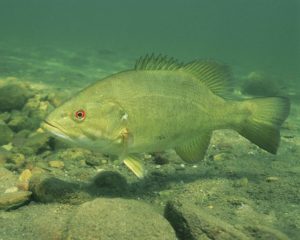
Freshwater doesn’t contain the salt content and make up many of the North American lakes, ponds, rivers, and streams.
Some common freshwater fish are bluegills, carp, catfish, crappie, bass, perch, northern pike, trout, and walleye.
Freshwater fish can have more of a musky taste, some are great for eating. I personally prefer trout and perch.
In Summary, combining fishing and SUP brings the best of two worlds together. Fishing on a SUP has many advantages and makes for another thrilling experience for SUP riders.
Please comment below on anything that you enjoyed from this post or your experiences with fishing on a paddle board.
